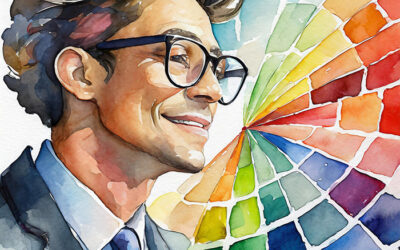A handful of months ago, I wrote a blog post discussing the intersection of creativity and AI. It was merely a week before Adobe released their Generative AI into the Photoshop Beta and changed the game for digital artists and graphic designers alike. The technological advances being made in AI are undoubtedly impressive, but as a designer myself, I can’t help but wonder what this means for our industry.
How Far Has AI Progressed in Graphic Design?
In just a few short months, the design landscape has undergone significant changes, particularly since the introduction of generative AI. This technology is rapidly expanding and can potentially transform many sectors of business. And is no longer limited to basic tasks like colorization or image resizing.
From the initial stages, where AI struggled to render accurate representations, leading to distorted and laughable images of hands, the journey of AI in graphic design has been nothing short of astonishing. We’re now in an era where AI can create coherent text on book cover mockups and generate entire additional scenes in existing images.
But as impressive as this technology may be, it’s important to note that AI still has limitations. It cannot fully replicate the decision-making process of a trained graphic designer and lacks true innovation and originality.
While AI can create aesthetically pleasing creations, it cannot understand complex emotions or convey meaningful messages in the same way a human designer can. Additionally, even the best AI creation will only be as good as the given inputs.
The Pros and Cons of AI in Graphic Design
The use of AI in graphic design comes with its set of advantages and disadvantages. On the positive side, AI can augment and accelerate design in numerous ways, enhancing realism and creativity. Many marketing teams already use AI to create ads and email campaigns, and it’s only expected to evolve further.
However, despite these benefits, there are also drawbacks. For instance, known algorithmic harms such as bias and discrimination are issues that need attention. Moreover, AI lacks the level of intuition and creativity of a human designer. While AI can provide shortcuts that reduce the time required for certain tasks, it cannot completely replace a trained graphic designer’s creativity and design skills.
Inadequacy of AI Tools for Complex Design Challenges
While AI tools have shown promising capabilities in the field of graphic design, they are often not suited for complex design challenges. Generative AI, while excellent for routine tasks and creating standard designs, struggles with intricate and nuanced design projects that demand a higher level of creativity and conceptual thinking.
At their core, AI tools operate based on pre-existing data and algorithms. This means they are constrained by what they have been programmed to do and lack the human ability to think outside the box, innovate, and adapt to unanticipated design problems.
AI tools encounter significant challenges when dealing with intricate projects such as infographics. Infographics require a sophisticated understanding of data, an ability to tell a story visually, and a delicate balance between text, design elements, and color. While AI can manage data and even generate basic designs, it often falls short in its capacity to weave all elements together into a compelling narrative that resonates with the intended audience].
Additionally, maintaining consistent branding and design across multiple channels is particularly difficult for AI. Different platforms have distinct interfaces, audience behaviors, and design requirements. This calls for intuitive understanding and customization — the ability to tweak designs subtly while ensuring they stay true to the brand’s identity. Despite the strides made in machine learning, AI currently lacks this nuanced understanding and adaptability.
AI Doesn’t Know How to Make the Logo Bigger
One of the most crucial aspects of graphic design is the relationship between the designer and the client. This relationship is built on mutual understanding, communication, and the flexibility to adapt to changing requirements. A designer creates visuals and interprets the client’s vision, their brand’s identity, and the message they want to convey.
AI, however advanced, cannot replicate this unique human interaction. The process of discussing ideas, making adjustments based on feedback, and understanding the client’s evolving requirements is something that AI currently falls short of. This is largely due to its inability to interpret ambiguous human expressions and emotions. AI can analyze data and generate output based on pre-set criteria, but it lacks the human ability to empathize, interpret non-verbal cues, and engage in creative problem-solving. AI can only do what it is told.
Furthermore, the design process often involves back-and-forth discussions, brainstorming sessions, and iterations – experiences that AI cannot participate in or fully comprehend. The nuances of human communication, the subtle changes in tone, and the ability to negotiate and compromise are beyond AI’s reach. Therefore, while AI can undoubtedly aid the design process, the role of a human designer in understanding and managing client relationships is irreplaceable.
Legal Ramifications of Using AI in Graphic Design
As AI becomes more prevalent in graphic design, it also brings along legal ramifications. One of the key issues involves copyright. With AI’s ability to generate realistic images, it’s crucial to establish who owns the rights to these creations.
AI-Generated Works and Copyright Law: A Court Ruling
In a landmark ruling, in early 2023 a U.S. court pronounced that AI-generated works aren’t copyrightable. The U.S. Copyright Office’s Compendium of U.S. Copyright Office Practices, Third Edition, currently states, “Only works created by a human can be copyrighted under United States law, which excludes works created by animals or by nature or by machines or automated processes.”. This stance was upheld in the court ruling, reinforcing that copyright law only protects “the fruits of intellectual labor” that “are founded in the creative powers of the mind.”
This ruling significantly impacts the graphic design industry, especially concerning AI-aided design. As AI capabilities continue to advance, the line between human-made and AI-generated content becomes increasingly blurred. Many questions arise, such as who owns the rights to a work primarily created by AI but tweaked by a human? Can portions of AI-generated designs be considered human creative expression? The current law and the court ruling don’t provide clear-cut answers to these complex issues. However, the ruling sets a precedent, suggesting that copyright privilege won’t easily extend to AI-generated creations in the immediate future.
Conclusion: Will Graphic Designers be Replaced By AI?
In just a few short months, AI has undeniably revolutionized the graphic design industry. It provides valuable tools and resources that can aid in design tasks. However, it is not going to replace human designers in the next few months, if ever. The creativity, intuition, and understanding of a human designer are irreplaceable and continue to be essential in the design industry.
As a tool, AI can be helpful, time-saving and reduce many mundane tasks. But in more complex design challenges, it’s not a substitute for human creativity and expertise that is necessary to deliver truly exceptional designs. As AI continues to evolve and integrate further into the field of graphic design, it will be crucial to navigate its limitations while leveraging its strengths to create impactful visual designs.
Much like in the ’90s when design software like Photoshop and Quark first emerged and disrupted the graphic design industry, AI is now leading the next wave of significant changes. Design software revolutionized the industry by automating many manual tasks, allowing designers to create complex designs more efficiently and with greater precision.
Now, AI is pushing these boundaries further, automating not just procedures but also the creative process to an extent. While this may raise concerns about the role of human designers, it’s important to remember that AI, like Photoshop and Quark previously, is a tool. The introduction of new tools invariably leads to changes and challenges but also to progress. AI is likely to reshape the graphic design industry, but human creativity, empathy, and understanding will always remain an indispensable part of the process.





0 Comments